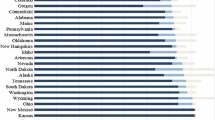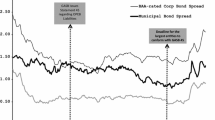Abstract
This research examines the measurement and impounding of alternative measures of a corporation's other postretirement benefits obligation (OPEBs) by an important segment of the capital markets. The Kaplan and Urwitz (1979) model is used as a benchmark from which to assess the importance of an added OPEB variable in the bond rating process. Using the corporate bond rating as the dependent variable, multiple measures of the OPEB obligation are inserted individually as an added independent variable into an N-chotomous probit model. The results for 1987 and 1988 indicate that measures calculated from publicly available information produce highly significant results. The developed postretirement liability measures are found to provide relevant and material information regarding the risk level of a firm's bonds as represented by its bond rating. This insight concerning the additional risk represented by a firm's postretirement benefits is beyond that supplied by the firm's pension information. This suggests that the additional investor default risk attributed to a firm's OPEB can be reasonably proxied by data found in the company's annual report footnote disclosures.
Similar content being viewed by others
References
Aldrich, J.H. and F.D. Nelson, Linear Probability, Logit, and Probit Models. Sage Publications, London, 1984.
Amir, E., “The Market Valuation of Accounting Information: The Case of Post-Retirement Benefits Other Than Pensions.” The Accounting Review 68, 703–724, (October 1993).
Barth, M.E., “Relative Measurement Errors Among Alternative Pension Asset and Liability Measures.” The Accounting Review 66, 433–463, (July 1991).
Barth, M.E., W.H. Beaver, and W.R. Landsman, “The Market Valuation Implication of Net Periodic Pension Cost Components.” Journal of Accounting & Economics 15, 27–62, (March 1992).
Coopers & Lybrand, Hewitt Associates, Non-Pension Benefits For Retired Employees. Financial Executives Research Foundation, Morristown, New Jersey, 1985.
Daley, L.A., “The Valuation of Reported Pension Measures for Firms Sponsoring Defined Benefit Plans.” The Accounting Review 59, 177–198, (April 1984).
Dhaliwal, D.S., “Measurement of Financial Leverage in the Presence of Unfunded Pension Obligations.” The Accounting Review 61, 651–661, (October 1986).
Durkee, A., J.E. Groff, and J.R. Boatsman. “The Effects of Costly vs. Costless Pension Disclosures on Common Share Prices: The Case of SFAS 36.” Journal of Accounting Literature 7, 180–196, (1988).
Ederington, L.H., “Classification Models and Bond Ratings.” The Financial Review 20, 237–262, (November 1985).
Employee Benefit Research Institute, Measuring and Funding Corporate Liabilities For Retiree Health Benefits. Employee Benefit Research Institute, 1988.
Espahbodi, H., E. Strock, and H. Tehranian, “Impact on Equity Prices of Pronouncements Related to Nonpension Postretirement Benefits.” Journal of Accounting and Economics 14, 323–346, (1991).
Feldstein, M., and R. Morck, “Pension Funds and the Value of Equities.” Financial Analysts Journal 39, 29–39, (September–October 1983).
Financial Accounting Standards Board, “Postretirement Health Care and Life Insurance Benefits.” Statement of Financial Accounting Standards No. 81. FASB, Norwalk, CT, 1984.
Financial Accounting Standards Board, “Employers' Accounting for Pensions.” Statement of Financial Accounting Standards No. 87 FASB, Norwalk, CT, 1985.
Financial Accounting Standards Board, “Employers' Accounting For Postretirement Benefits Other Than Pensions.” Exposure Draft No. 78. FASB, Norwalk, CT, 1989.
Financial Accounting Standards Board, “Employers' Accounting for Postretirement Benefits Other Than Pensions.” Statement of Financial Accounting Standards No. 106. FASB, Norwalk, CT 1990.
Financial Executives Research Foundation, Retiree Health Benefits: Field Test of the FASB Proposal. Financial Executives Research Foundation, Morristown, New Jersey, 1989.
Fisher, L., “Determinants of Risk Premiums on Corporate Bonds.” Journal of Political Economy 67, 217–237, (June 1959).
Geisel, J. “Retiree Obligations Soar.” Business Insurance 2, 20, (July 1993).
Gerboth, D.L., “FASB Standard on Accounting for Other Postretirement Benefits Takes Shape.” The CPA Journal 60, 44–51, (August 1990).
Goh, J.C. and L.H. Ederington, “Is a Bond Rating Downgrade Bad News, Good News, or No News for Stockholders?” Journal of Finance 48, 2001–2008, (December 1993).
Harper, R.M., W.G. Mister, and J.R. Strawser, “The Impact of New Pension Disclosure Rules on Perceptions of Debt.” Journal of Accounting Research 25, 327–330, (Autumn 1987).
Harper, R.M., W.G. Mister, and J.R. Strawser, “The Effect of Recognition Versus Disclosure of Unfunded Postretirement Benefits on Lenders' Perceptions of Debt.” Accounting Horizons 5, 50–56, (September 1991).
Hopwood, J., J. McKeown, and J. Mutchler, “The Sensitivity of Financial Distress Prediction Models to Departures from Normality.” Contemporary Accounting Research 5, 284–298, (Fall 1988).
Horrigan, J.O., “The Determination of Long-Term Credit Standing With Financial Ratios.” Journal of Accounting Research 8, 44–62, (Supplement 1966).
Inder, K.K. and M.L. Loudder, “The Economic Consequences of SFAS 106 in Rate-regulated Enterprises.” The Accounting Review 69, 364–380, (April 1994).
Iskandar-Datta, M.E. and D.R. Emery, “An Empirical Investigation of the Role of Indenture Provisions in Determining Bond Ratings.” Journal of Banking & Finance 18, 93–111, (January 1994).
Kaplan, R.S. and G. Urwitz, “Statistical Models of Bond Ratings: A Methodological Inquiry.” Journal of Business 52(2), 231–260, (1979).
Landsman, W., “An Empirical Investigation of Pension and Property Rights.” The Accounting Review 61, 662–691, (October 1986).
Landsman, W. and J.A. Ohlson, “Evaluation of Market Efficiency for Supplementary Accounting Disclosures: The Case of Pension Assets and Liabilities.” Contemporary Accounting Research 7, 185–198, (Fall 1990).
Maher, J.J., “Pension Obligations and the Bond Credit Market: An Empirical Analysis of Accounting Numbers.” The Accounting Review 62, 785–798, (October 1987).
Martin, L.J. and G.V. Henderson Jr., “On Bond Ratings and Pension Obligations: A Note.” Journal of Financial and Quantitative Analysis 18, 463–470, (December 1983).
McCarthy, J.E. and R.W. Melicher, “Analysis of Bond Rating Changes in a Portfolio Context.” Quarterly Journal of Business and Economics 27, 69–86, (Autumn 1988).
McKelvey, R.D. and W. Zavoina. “A Statistical Model for the Analysis of Ordinal Level Dependent Variables.” Journal of Mathematical Sociology 4, 103–120, (1975).
Mittelstaedt, H.F. and M. Warshawsky. “The Impact of Liabilities for Retiree Health Benefits on Share Prices.” Journal of Risk and Insurance 60, 13–35, (March 1993).
Morris, M.H. and W.D. Nichols, “Pension Accounting and the Balance Sheet: The Potential Effect of the FASB's Preliminary Views.” Journal of Accounting, Auditing & Finance 7, 293–305, (Summer 1984).
Pastena, V., “dDiscussion of Evaluation of Market Efficiency for Supplementary Accounting Disclosures: The Case of Pension Assets and Liabilities.” Contemporary Accounting Research 7, 199–202, (Fall 1990).
Pinches, G.E. and K.A. Mingo, “The Role of Subordination and Industrial Bond Ratings.” The Journal of Finance 28, 1–18, (March 1973).
Pinches, G.E. and K.A. Mingo, “A Multivariate Analysis of Industrial Bond Ratings.” The Journal of Finance 30, 201–206, (March 1975).
“Retirees, Companies Head for Showdown Over Moves to Reduce Health Coverage,” Wall Street Journal B1, (May 17, 1990).
Rue, J.C. and A.G. Volkan, “Financial and Economic Consequences of the New Pension Accounting Proposals: Is the Gloom Justified?” Journal of Accounting, Auditing & Finance 7, 306–322, (Summer 1984).
SAS Institute Inc., Version 6, Fourth Edition Volume 2. SAS/STAT User's Guide, SAS Institute Inc., Cary, NC, 1990.
Stone, M., “Discussion of the Effects of Costly vs. Costless Pension Disclosures on Common Share Prices: The Case of SFAS No. 36.” Journal of Accounting Literature 7, 197–201, (1988).
Thomas, P.B. and L.E. Farmer, “OPEB: Improved Reporting or the Last Straw?” Journal of Accountancy 170, 102–112, (November 1990).
Volkert, L.A., “Accounting for OPEB Costs and Regulatory Assets.” Journal of Accountancy 172, 93–96, (July 1993).
Warshawsky, M.J., H.F. Mittelstaedt, and C. Cristea, “Recognizing Retiree Health Benefits: the Effect of SFAS 106.” Financial Management 22, 188–199, (Summer 1993).
Wilbert, J.R. and K.E. Dakdduk, “The New FASB 106: How to Account for Postretirement Benefits.” Journal of Accountancy 170, 36–41, (August 1991).
Zaima, J.K. and J.E. McCarthy. “The Impact of Bond Rating Changes on Common Stocks and Bonds: Tests of the Wealth Redistribution Hypothesis.” The Financial Review 23, 483–498, (November 1988).
Author information
Authors and Affiliations
Rights and permissions
About this article
Cite this article
Maher, J.J. Perceptions of postretirement benefit obligations by bond rating analysts. Rev Quant Finan Acc 6, 79–94 (1996). https://doi.org/10.1007/BF00290798
Issue Date:
DOI: https://doi.org/10.1007/BF00290798




